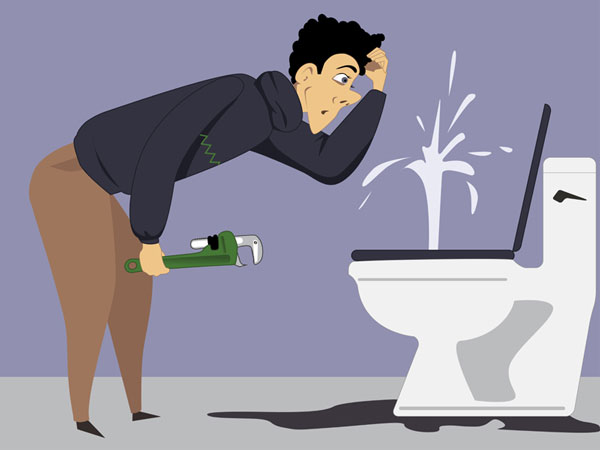A toilet that won’t stop running is one of the more annoying things we have to deal with. Part of what makes it so annoying is the fact that there can be several different causes, which makes fixing the problem difficult.
Whether you hear water running constantly or cycling on and off, this guide will help you decipher the clues so you can stop most leaks. Even if you don’t have plumbing experience, many of the fixes for a running toilet are quite simple.
A toilet really only has two moving parts: the float and valve assembly, and the stopper that controls the release of water. When you release the water, it splits between the top of the bowl and the bottom, creating a Venturi effect that sucks down the waste.
Faulty Flapper
One cause of a running toilet is a flapper that doesn’t seal. Does water from the tank seep around the flapper and into the bowl? If so, then your flapper is probably damaged. Test for a leaky flapper by pushing down on it with a stick when you hear the water running. If the water stops, you know the flapper isn’t sealing properly and should be replaced.
Replacing the Flapper
To replace the flapper, first shut off the water supply valve under the toilet or the main supply if necessary. Flush the toilet to drain out most of the water, and unhook the old flapper. Buy a new flapper of the same type and install it according to the instructions on the package. Hook the flapper chain onto the flush lever arm so there’s a little slack when the flapper is closed.
Check the Overflow Pipe
If the flapper doesn’t leak and the water still runs, inspect the fill tube connected to the overflow pipe. The end should be above the water line. If the end is under water, cut it back. Next, inspect the fill valve for visible signs of wear and test the float. If the float is improperly adjusted, the tank water level can rise above the overflow pipe and drain into it. Replace the old fill valve if it doesn’t completely shut off or it hampers the float arm’s operation.
Install a New Fill Valve
Install a new “float cup”-style fill valve. Adjust the float according to the package instructions to establish the proper water level. Finish the installation by attaching the flapper chain to the flush lever as described above. Turn on the water and test flush the toilet.
Check the Float
The traditional float is a big ball at the end of a rod that controls the valve that fills the tank after a flush. More common these days is a donut-shaped float that slides up and down on the overflow tube or an internal float that shuts the water valve when it hits a certain level.
Either way, if the tank isn’t filling up as much as needed to flush properly, make sure the float isn’t leaking. If it is, it’ll need replacing.
Get a Plumber
If all this hasn’t worked you probably need to replace the whole toilet mechanism, as it may be beyond repair. Removing and reinstalling a toilet’s innards is a big job. You’ll be best of getting in touch with your local Canberra plumbers to make sure it’s done right.

